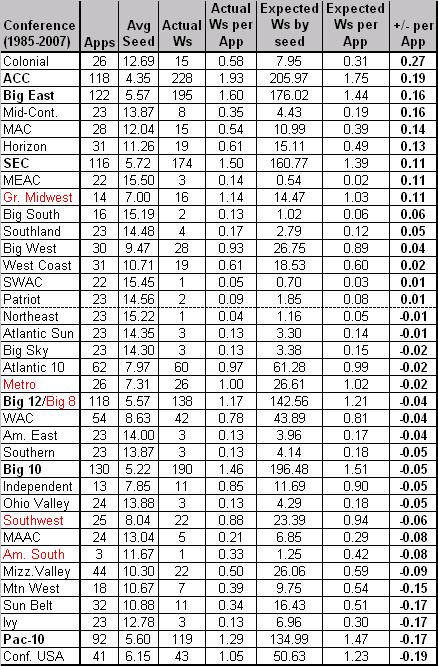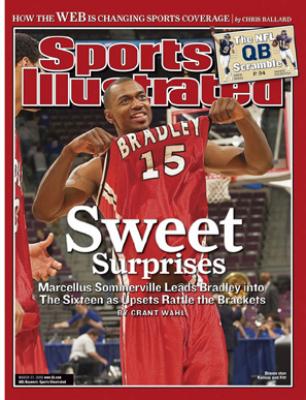John Stevens is a featured writer for Rush The Court. His column appears on Tuesdays throughout the season.
All right, now we’re talking. We’re several games into conference play, now, and the leagues are starting to take shape. We’ve known the fates of some teams for a long time, both the good (your Carolinas and Dukes, Oklahomas and UConns, etc), and the bad (no need to pile on, here). The most interesting part of it all, to me, are those teams which are doing a little better than they expected and may be making tenuous hotel reservations for a very large dance in March…and others that are becoming quickly aware that they are only one or two losses away from being tossed into the dustbin of NIT-worthiness. Even worse, many squads are realizing that they may not even have THAT to worry about, that there will be no post-season, that the only thing they have waiting on them after the basketball season is over is — horror of horrors — going to class.

- Many teams know this is all they have to look forward to in March. (photo credit: photobucket.com)
So who’s not behaving like we expected? Who has both surprised and disappointed us, in terms of conference play? Without further delay, I give you…our early-conference edition of Over- and Underachievers.
ACC
Overachiever: Virginia Tech (14-5, 4-1)
As much as their win over then-#1 Wake Forest turned heads, I think people were just as surprised (at least I was) that they avoided the usual post-big-victory letdown by going to Miami (FL) four days after the Wake win and knocking off what I still think is a very capable Hurricane squad. I know it’s early. But right now it’s the Hokies who sit second in the conference, a game behind new national #1 Duke. Victories like the ones they’ve enjoyed so far can sometimes set the tone for a great season, or they can make you overconfident so that you screw up the rest of your conference schedule. We’ll see how far they can take it, but you’ve got to give them props to this point.

- Greenberg and Vassallo, Overachievers. (photocredit: daylife.com)
Underachiever: Georgia Tech (9-10, 0-6)
Whew. What happened here? After starting 7-2, something happened just before Christmas and the Jackets just haven’t gotten up from it. Maybe the competition just got a little better, but with all the talent on this team and a coach like Paul Hewitt there’s just no excuse for going one-for-2009. Their only victory of this year? A 5-point win at home against Georgia, a bottom-feeder team in a terrible SEC. To be completely honest, I’m already tired of talking about them. Maybe next year Derrick Favors will bring the antidote this program needs.
Big 12
Overachiever: Missouri (17-3, 4-1)
Hands up, who had Missouri at 17-3 after 20 games? Yeah, me neither. The Tigers have great individual talent but have succeeded this year by being the epitome of unselfishness, which has led to efficiency. They average 19.4 assists per game (2nd nationally), just a ridiculous number. The only question mark…only three true away games so far. Probably the only reason they aren’t well-entrenched in the Top 25 right now.

- Missouri’s DeMarre Carroll, a large human, happy about overachieving. (photo credit: daylife.com)
Underachiever: Texas A&M (15-5, 1-4)
That 14-1 start was lookin’ pretty good, then conference play started. 12 assists per game just isn’t going to get it done (248th in the nation). Donald Sloan averages the most dimes per game on this team at a mere 3.2. We’re pretty sure Mark Turgeon is a fine coach, but right now the Aggies are giving the NCAA Tournament committee reasons to deny them entry in March. They’d best learn to stay afloat for the rest of Big 12 play.
Big East
Overachiever: Marquette (18-2, 7-0)
Winners of 10 straight. RPI of 15. 7-0 in a monster conference. The coolest thing about Marquette is that they’ll beat you any way you wish to get beaten — they can play slow, half-court basketball and cut you to pieces, and they’re also more than happy to outrun you and get it up near triple-digits. And Monday night was telling — I bet Maurice Acker followed Kyle McAlarney to class today. McAlarney couldn’t have gotten have rid of him even if he’d cut the brake lines on Acker’s car. The Jerel McNeal/Wesley Matthews/Lazar Hayward three-headed monster has turned into one of the most fearsome in the game. DO NOT forget this team when filling out your bracket in the office pool in a month and a half.

Underachiever: Seton Hall (10-9, 1-6)
The Pirates raised some eyebrows when they started off 9-3 including wins versus Southern Cal and Virginia Tech, and then — sense a trend, here? — conference play began. Boom, six straight losses. I think the Georgetown game really showed us something closer to who the real Seton Hall team is, but this conference is going to end up being just too vicious overall for them.
SEC
Overachiever: Kentucky (16-4, 5-0)
According to a number of my Wildcat connections, before this season, UK supporters were basically ready to give Billy Gillispie another “free-pass” sort of season, inasmuch as a coach can actually have that at Kentucky. Doesn’t look like Gillispie needs it. This team is an interesting statistical mix. They rank 3rd in the country in FG% (50.2%) and 2nd nationally in FT% (79%). We know about the potency of the Jodie Meeks/Patrick Patterson tandem. Defensively, they hold opponents to 36.4% a game from the field, which is 3rd best in the nation; and they rank second in the country in blocks per game with 7.5 (and, oddly, second in the conference as well behind Mississippi State’s 8.0/game). So…great offense, great defense…what’s the problem? Well, how about 18.1 turnovers per game? That’s 338th out of 341 Division One teams. Egad. Nobody — even Kentucky fans, I don’t think — saw Kentucky improving this fast with so many unknowns starting the year. Clean up the turnovers and you’re a top five team.

- Class of the SEC? We’ll see… (photo credit: daylife.com)
[Ed. note: since this was written, Kentucky was defeated by Mississippi on Tuesday night to give UK its first loss in the conference and take them to 5-1. I think, however, that UK still qualifies for Overachiever status in the SEC so far for reasons outlined above. –J.S.]
Underachiever: Arkansas (12-5, 0-4)
If you look at the win-loss pattern on Arkansas’ schedule, you’d say, “Yep, conference play, again.” I don’t think you can’t say that, here. It’s baffling, because in an eight-day span less than a month ago, John Pelphrey’s Razorback squad knocked off both Texas and Oklahoma, not exactly a couple of pansies. It makes absolutely no sense that beginning conference play in a WAY-down SEC (6th in conference RPI, and probably falling) would cause Arkansas any problems at all, but here they sit at 0-4 in the conference, including an inexcusable 22-point home court butt-smoking at the hands of Auburn. Arkansas is another team that is just loaded with great athletes, and if they straighten up a little the committee will remember those two earlier big wins. Arkansas reminds me of Avril Levigne. I’m pretty sure there’s something attractive there…but they’re doing whatever they possibly can to screw it up and make themselves ugly.

- Avril has a message for Mr. Stevens (photo credit: radaronline.com)
This is not a complete list, by any means. But I think it shows us how breezing through questionable non-conference opponents might not be the best recipe to impress the committee, as attractive as it is to post a nice big number in the pre-conference ‘W’ column. Everyone knows that late losses simply mean more, that the committee likes you to finish strong. You can’t allow yourself to be a conference underachiever. Conference play will give you a bellyache if all you’ve been doing is loading up on cupcakes.





















































